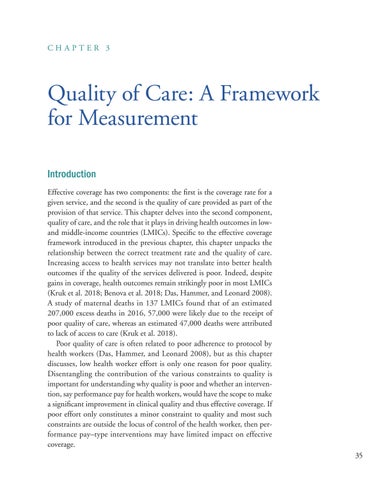CHAPTER 3
Quality of Care: A Framework for Measurement Introduction Effective coverage has two components: the first is the coverage rate for a given service, and the second is the quality of care provided as part of the provision of that service. This chapter delves into the second component, quality of care, and the role that it plays in driving health outcomes in lowand middle-income countries (LMICs). Specific to the effective coverage framework introduced in the previous chapter, this chapter unpacks the relationship between the correct treatment rate and the quality of care. Increasing access to health services may not translate into better health outcomes if the quality of the services delivered is poor. Indeed, despite gains in coverage, health outcomes remain strikingly poor in most LMICs (Kruk et al. 2018; Benova et al. 2018; Das, Hammer, and Leonard 2008). A study of maternal deaths in 137 LMICs found that of an estimated 207,000 excess deaths in 2016, 57,000 were likely due to the receipt of poor quality of care, whereas an estimated 47,000 deaths were attributed to lack of access to care (Kruk et al. 2018). Poor quality of care is often related to poor adherence to protocol by health workers (Das, Hammer, and Leonard 2008), but as this chapter discusses, low health worker effort is only one reason for poor quality. Disentangling the contribution of the various constraints to quality is important for understanding why quality is poor and whether an intervention, say performance pay for health workers, would have the scope to make a significant improvement in clinical quality and thus effective coverage. If poor effort only constitutes a minor constraint to quality and most such constraints are outside the locus of control of the health worker, then performance pay–type interventions may have limited impact on effective coverage. 35

